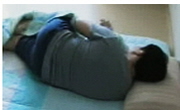본 연구의 목적은 조산으로 출생한 영유아와 일반 영유아의 감각처리능력과 섭식, 수면 차이를 비교하고 조산으로 출생한 영유아의 감각처리능력과 섭식, 수면의 상관관계를 알아보는 것이...
http://chineseinput.net/에서 pinyin(병음)방식으로 중국어를 변환할 수 있습니다.
변환된 중국어를 복사하여 사용하시면 됩니다.
- 中文 을 입력하시려면 zhongwen을 입력하시고 space를누르시면됩니다.
- 北京 을 입력하시려면 beijing을 입력하시고 space를 누르시면 됩니다.
조산으로 출생한 영유아의 감각처리특성과 섭식, 수면의 상관관계 = A Study on Correlation of Sensory Processing Characteristics with Feeding and Sleeping of Preterm Infants and Toddlers
한글로보기https://www.riss.kr/link?id=T15357537
- 저자
-
발행사항
김해 : 인제대학교 일반대학원, 2019
-
학위논문사항
학위논문(석사) -- 인제대학교 일반대학원 , 작업치료학과 , 2019. 8
-
발행연도
2019
-
작성언어
한국어
- 주제어
-
발행국(도시)
경상남도
-
형태사항
; 26 cm
-
일반주기명
지도교수: 김경미
-
UCI식별코드
I804:48012-200000226567
- 소장기관
-
0
상세조회 -
0
다운로드
부가정보
국문 초록 (Abstract)
본 연구의 목적은 조산으로 출생한 영유아와 일반 영유아의 감각처리능력과 섭식, 수면 차이를 비교하고 조산으로 출생한 영유아의 감각처리능력과 섭식, 수면의 상관관계를 알아보는 것이다.
본 연구의 대상자는 107명으로 조산아 51명, 일반아동 56명이었다. 감각처리능력을 평가하기 위해 Infant/Toddler Sensory Profile(ITSP)2를 사용하였고 섭식행동을 평가하기 위해 Behavioral Pediatrics Feeding Assessment(BPFAS)를 사용하였다. 수면특성을 평가하기 위해 Brief Infant Sleep Questionnaire(BISQ)를 사용하였다. 수집된 자료는 SPSS 21.0을 사용하여 분석하였다. 통계적인 유의성 검증을 위해 유의수준은 α=.05로 설정하였다. 조산아와 일반아동의 차이를 알아보기 위하여 독립표본 t 검정을 사용하였으며, 조산아의 감각처리능력과 섭식, 수면의 상관관계를 알아보기 위해 Pearson 상관분석을 사용하였다.
조산아와 일반아동의 감각처리능력을 비교한 결과 감각특성 중 감각예민(p=.019), 하위영역 중 구강감각처리능력(p=.001)에서 유의한 차이를 보였다. 또한 조산아와 일반아동의 섭식행동을 비교한 결과 유의한 차이를 보였다(p=.00).
조산아의 감각처리특성 중 감각회피(r=.443), 감각예민(r=.374)은 섭식빈도와 양의 상관관계를 보였고 감각처리 하위영역 중 일반적 행동(r=.390), 구강감각처리(r=.513)는 섭식빈도와 양의 상관관계를 보였으며 구강감각처리(r=.529)는 섭식문제와 양의 상관관계를 보였다. 수면 특성 중 밤에 깨는 횟수는 감각처리특성 중 감각회피(r=.437)와 감각처리 하위영역 중 일반적 감각처리(r=.283), 행동적 반응(r=.385)과 양의 상관관계를 보였고 재우는데 걸리는 시간은 감각특성 중 등록저하(r=-.323)와 음의 상관관계를 보였다. 밤에 자는 시간은 감각처리 하위영역에서 청각처리(r=-.364), 촉각처리(r=-.335)와 음의 상관관계가 있었으며 낮잠시간은 움직임처리와(r=-.385) 음의 상관관계가 있었다.
본 연구는 조산아와 일반아동의 감각처리능력과 섭식에서 차이가 있는 것을 확인하였다. 또한 조산아의 감각처리능력은 섭식, 수면과 상관관계가 있는 것을 알 수 있었다.
본 연구를 통해 조산아의 감각처리특성과 섭식, 수면의 상호관련성을 알아보고 조산아의 섭식과 수면을 이해하기 위해 감각처리능력이 중요하다는 근거를 제시하는데 의의가 있다.
다국어 초록 (Multilingual Abstract)
The purpose of this study was to compare the difference between preterm infants and toddlers (PT) and full-term infant and toddler(FT) of sensory processing characteristics, feeding and sleep as well as investigate the correlation of sensory processin...
The purpose of this study was to compare the difference between preterm infants and toddlers (PT) and full-term infant and toddler(FT) of sensory processing characteristics, feeding and sleep as well as investigate the correlation of sensory processing characteristics with feeding and sleep of preterm infants and toddlers.
The subjects of a study were 107 including Infant/Toddler Sensory Profile (ITSP) 2 was used to assess sensory processing characteristics. The Behavioral Pediatrics Feeding Assessment (BPFAS) was used to assess feeding behavior. Brief Infant Sleep Questionnaire (BISQ) was used to assess sleep characteristics. The collected data were analyzed by using SPSS 21.0. statistical significance level was set α= .05. Independent sample t-test was used in order to compare the difference between PT group and FT group. Pearson correlation analysis was used in order to investigate the correlation of sensory processing characteristics with feeding and sleep of preterm infants and toddlers.
There was a significant difference in sensory sensitivityt and oral sensory processing between with PT group and FT group (p<0.05). There was a significant difference in feeding behavior between with PT group and FT group(p<.05). In PT group, there are positive correlations of sensory avoidance (r=.443) and sensory sensitivity (r=.374) with feeding frequency. General behavior(r=.390) and oral sensory processing(r=.513) showed a positive correlation with feeding frequency. In addition, oral sensory processing(r=.529) showed a positive correlation with feeding problem.
In the sleep characteristics, the number of night wakenings were positively correlated sensory avoidance(r=.437), general sensory processing(r=.283) and behavioral response (r=0.385). There were negative correlations of night sleep duration(r=-0.323) with auditory processing(r=-.364) and tactile processing(r=-.335). In addition to, day sleep time was negatively correlated with movement processing(r=-.385).
It is proved that the interrelationship of sensory processing characteristics with feeding and sleep of preterm infants and toddlers. And it is meaningful to recognize significance of sensory processing characteristics to comprehend feeding and sleep of preterm infants and toddlers.
목차 (Table of Contents)
- 목 차
- 국문초록 ⅲ
- Abstract ⅴ
- 목 차
- 국문초록 ⅲ
- Abstract ⅴ
- Ⅰ. 서론 1
- A. 연구의 필요성 1
- B. 연구의 목적 5
- Ⅱ. 이론적 배경 6
- A. 조산아의 감각처리능력 6
- B. 감각처리와 관련된 섭식 8
- C. 감각처리와 관련된 수면 10
- Ⅲ. 연구방법 12
- A. 연구대상 12
- B. 연구도구 14
- 1. 영유아감각프로파일2 14
- 2. 아동섭식행동평가 15
- 3. 영유아수면설문평가 16
- C. 연구과정 17
- D. 분석방법 19
- Ⅳ. 연구결과 20
- A. 조산아와 일반아동의 감각처리능력 비교 20
- 1. 조산아와 일반아동의 감각처리특성 비교 20
- 2. 조산아와 일반아동의 감각처리특성 결과 분포 21
- 3. 조산아와 일반아동의 감각처리 하위영역 비교 22
- 4. 조산아와 일반아동의 감각처리 하위영역 결과 분포 23
- B. 조산아와 일반아동의 섭식행동 비교 24
- 1. 조산아와 일반아동의 섭식행동 비교 24
- 2. 조산아와 일반아동의 섭식빈도와 섭식문제 결함 차이 25
- C. 조산아의 일반아동의 수면특성 비교 26
- D. 조산아의 감각처리능력과 섭식행동의 상관관계 27
- 1. 조산아의 감각처리특성과 섭식행동의 상관관계 27
- 2. 조산아의 감각처리 하위영역과 섭식행동의 상관관계 28
- E. 조산아의 감각처리능력과 수면특성의 상관관계 29
- 1. 조산아의 감각처리특성과 수면특성의 상관관계 29
- 2. 조산아의 감각처리 하위영역과 수면특성의 상관관계 30
- Ⅴ. 고찰 31
- Ⅵ. 결론 42
- 참고문헌 43
- 부록 53












